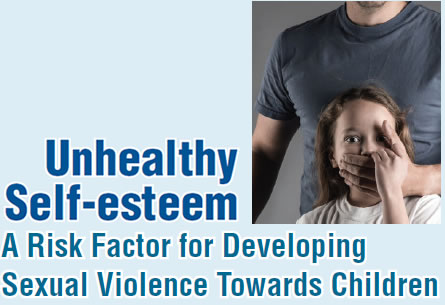Insights from the therapeutic practises for child sexual abuse offenders explain the correlation between sexual offenders’ self-esteem and their sexual violence towards children. Earlier the treatment for sex offenders addressed the sexual deviance directly, focusing on the behavioural interventions and cognitive interventions. Later more comprehensive treatment programmes were developed to include interventions that targeted self-esteem as well (Harkins & Thomas-Peter, 2010, p. 434).
Now, among the wide variety of treatment programmes for child sexual abuse offenders, most of them target the selfesteem of the offender (John Jay College of Criminal Justice, 2004, p. 185). Raising the self-esteem of sex offenders also reduces their tendency to re-offend and thereby prevents recidivism. Different instruments, like ‘Sex Offender Treatment Evaluation Project’ (STEP), ‘Initial Deviance Assessment’ (IDA) and ‘Sex Offender Need Assessment Rating’ (SONAR) are used to assess the risk of further sex offences of sex offenders as part of their therapeutic process. They include self-esteem among the dynamic risk factors for recidivism or recurrence of the offence (Beech et al., 2003, pp. 339–346). The Australian Institute of Criminology considered increasing offender capabilities by meeting non-criminogenic needs like low self-esteem as one of the basic rehabilitative goals to reduce sexual offences (Lievore, 2004, p. 76). To achieve the goal of decreased recidivism of sexual offending it is important to raise the self-esteem of the offender in the therapeutic set-up (Glaser, 2003, p. 145–146). Enhancement of the self-esteem and self-confidence of the offender can definitely break the cycle of delinquency and crime (Chou & Browne, 2010, p. 31).
There have been some empirical studies acknowledging such therapeutic insights. They assessed the improvements in sexual deviance among child molesters after they had been treated to enhance their self-esteem. One of such studies, conducted on 32 child molesters, concluded that the enhancement of self-esteem through treatment positively helped the molesters to overcome their deviance. These positive impacts were especially evident in intimacy needs and reduction of loneliness. The improvement in self-esteem helped the molesters to reduce their tendency (Marshall et al., 1997, p. 321).
Another study on non-familial child molesters assessed the relationship between their self-esteem and deviant sexual arousal. The study concluded that treatment helped to improve their self-esteem and the improvements correlated significantly with reductions in deviant arousal. This study also pointed to the exclusive interrelation between self-esteem and the dynamics within the mind of a child molester (Marshall, 1997, p. 86).
There have been very few studies on clerical child sexual abuse offenders. In America, ‘identity behaviour survey’ was conducted comparing the personal data of priests in active ministry of a similar age group who had or had not been accused of child sexual abuse. 119 accused priests and 361 non-accused priests participated in the survey. The results showed that accused priests had slightly lower self-esteem than non-accused priests, but the group of priests as a whole had generally high self-esteem scores. Since the conclusion drawn here is not as emphatic as that of other studies in highlighting the impact of self-esteem on their sexual deviance, researchers point out that it has to be interpreted cautiously since the sample sizes are very small (John Jay College of Criminal Justice, 2011, pp. 51 & 65).


